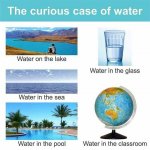I usually tend to think of it as being spherical; however, in a 'like' similarity to wave particle duality - the moon seems to exhibit both spherical and flat qualities.
For starters, what you said here is totally incorrect. In the FE model, the "dark side of the moon" is the 'top' of the moon. No one would ever be able to see it from the earth surface. Only the bottom side of it is seen from below.
True story. When I first wrote that part I wrote (in bold type), "one person would see one side of the moon,
and to a certain degree some common view of the bottom, and the other person would see the other side (sometimes called the Darkside of the Moon). But of course, we only see one side of the moon with the cycling phases." But then I deleted it, thinking to myself, "he knows what you mean, this is concept, keep it succinct and simple".
Yes,
in the FE model, if the moon is a sphere, depending on the moon's elevation and size, and the exact viewing angle from London, and from Sydney (Let's just match to the first video from my post which is specifying those geographic locations and actual photographic moon video), each viewer will see a certain degree of the "bottom bowl" portion of the moon. It's a matter of degree.
Are you familiar with the FE model of the moon's general elevation and course moving around the surface of FE? In FE model the moon hovers over the surface and it moves in a varying circle motion, like a spoon stirring around the surface of a pot of soup. This is how THEY explain night and day. Are you familiar? It's a very important make-or-break part of it: the night and day thing. If the moon doesn't have a geo-location hovering over the earth surface, a fair distance away from the sun (that's doing the same thing), then FE model doesn't have night and day. It's one of the more clever aspects of the FE model.
For this part, lets create a real-life nighttime scenario where you are in Ohio and I'm in southern Argentina looking at the moon at the same time. We can both zoom-in on the moon and live feed it to youtube, and look at both our images. For day/night purposes, geographically, we are both in the -5 GMT longitude zone (
longitude strip hyperlink). Obviously, with both models, we both get the sunrise in less than 60 mins of each other because that fact is observed every day. It's midnight 12:00 AM in Ohio. In the FE model that has day and night included, the moon travels between us roughly over the "equator line"; roughly midway between us.
In the FE model, it's dark/nighttime,
because the sun is so far away from us. The sun is on the other side of the FE map... it's noontime in Indonesia (which is on the SE equator). In our midnight, we can't see the sun, but we can see the moon. The moon must be closer to the surface (and us) than the sun is far away from us, right? We can't see the very bright sun, but we can see the not-so-bright moon. Now imagine the moon passing between us, some distance above the surface, like a satellite... you in Ohio, me in Argentina. You must be seeing some of the moon's surface from your vantage point (your side) that I'm not, and vise versa, right?
Of course, we don't see differing sides of the moon, but in the FE sun/moon model, we would. Which model is more likely correct based on the observations of the moon, "the turn of features" difference we see from England compared to Australia (
that video)? Here's an insulting video I found today that illustrates what I just presented above:
(1) Destroying Flat Earth Without Using Science - Part 1: The Moon - YouTube
A flat moon is the only FE explanation I've heard for this observation. Lastly, when it's nighttime and the moon is out, look at it. I think the Lord meant us to see it, and I say it plainly looks spherical. Would the Lord purposely give that illusion with a flat moon?

